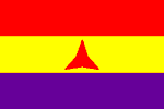Spain

Teniente Nicomedes Calvo Aguilar
Spain

Teniente Nicomedes Calvo Aguilar
In July 1937 capitán Ramón Puparelli Francia was ordered to take his ten I-15s to Santander to reinforce the northern fighter force, which had lost most of their aircraft in frequent air raids on Somorrostro airfield.
Four more I-15s under the command of teniente Juan Comas Borrás joined soon afterwards, so that 45 Chatos were now available for operations on the Northern front. They were reinforced by eight Soviet-flown I-16 Moscas led by Valentin Ukhov, which arrived on 2 July.
Capitán Ramón Puparelli Francia assumed command of both the I-15s and I-16s.
Following teniente José Riverola Grúas’ departure for the Central front, teniente Leopoldo Morquillas Rubio was appointed CO of the Escuadrilla de Chatos del Norte. The Escuadrilla de Chatos del Norte was comprised of the following pilots and aircraft during operations on the Santander front in July 1937:
| Unit | Pilot | Aircraft type | Aircraft code | ||||||||||||||||||||||||||||||||
| 1a Patrulla | Teniente Leopoldo Morquillas Rubio | I-15 | ’CA-57’ | ||||||||||||||||||||||||||||||||
| Teniente Jaime Buyé Berni | I-15 | ’35’ | |||||||||||||||||||||||||||||||||
| Teniente Calvo | I-15 | ’29’ | |||||||||||||||||||||||||||||||||
| Sargento Rafael Magriña Vidal | I-15 | ’13’ | |||||||||||||||||||||||||||||||||
| 2a Patrulla | Teniente Esteban Nazario Ortiz Bueno | I-15 | ’12’ | ||||||||||||||||||||||||||||||||
| Teniente Miguel San José Andrade | I-15 | ’50’ | |||||||||||||||||||||||||||||||||
| Sargento Miguel Galindo Saura | I-15 | ’28’ | |||||||||||||||||||||||||||||||||
| Sargento Andrés Rodríguez Panadero | I-15 | ’20’ | |||||||||||||||||||||||||||||||||
| 3a Patrulla | Teniente Juan Comas Borrás | I-15 | 59
| |
Teniente José González Feo |
I-15 |
’30’ |
|
Sargento Miguel Zambudio Martínez |
I-15 |
’62’ |
|
Sargento Ladislao Duarte Espés |
I-15 |
’23’ |
|
|
|
|
Reserve pilots |
Teniente Julián Barbero López |
|
|
Reserve pilots |
Sargento Antonio Rodríguez Jordán |
|
|
Reserve pilots |
Sargento Antonio Miró Vidal |
|
|
Reserve pilots |
Sargento Román Llorente Castro |
|
|
|
In December 1937 and after a 25-day leave teniente Gerardo Gil Sánchez turned over command as deputy of the 2a/26 to teniente Calvo.
On 10 December and in order to camouflage a planned Nationalist offensive towards Madrid on the Guadalajara, the Republican air forces were to be destroyed on their airfields east of Zaragoza. A Nationalist force of 88 bombers and 56 fighters took part in the operation. The slower bombers (SM.81s and Ju 52/3ms) were to attack the nearby airfields in the Barbastro zone; the faster bombers (SM.79s, Breguet 20s, He 111s and Do 17s) those at Sariñena, Bujaraloz, Candasnos, Puebla de Híjar, Selgua, Pomar, Lérida and Balaguer. The Condor Legion’s bombers, which had to operate from more distant bases, would require refuelling before making their return flight, and facilities were provided at Sanjurjo.
The attacks failed to achieve the desired success, however; the airfields were empty and about 70 fighters were waiting in the air. It must be said that the Republicans were very well prepared to deal with surprise air attacks. They had constructed a large number of airfields and at each was based at most a single squadron, its aircraft widely dispersed around the airfield perimeter. In addition, they had built a number of decoy airfield on with mock-up aircraft.
At least, the VI and XVI Gruppi of the Aviazione Legionaria took part in this combat and Tenente Corrado Santoro of the 31a Squadriglia (VI Gruppo) took part in an escort mission to bombers attacking Sariñena and Sottotenente Mario Visintini of the 25a Squadriglia (XVI Gruppo) took part in his first combat, firing at some enemy aircraft but without claiming anything.
At the end of the battle, the Italians claimed eight I-15s shot down for just one CR.32 lost and its pilot KIA when Sottotenente Vittorio Barberis of the 32a Squadriglia, was killed in action near Alcubierre when his CR.32 collided with I-15 CC-022, flown by Soviet pilot Mikhail Vasilhevich Kotyhov from the 1a/26. The latter pilot also perished.
Group 2-G-3, which was flying below the Italians, climbed to their assistance and claimed seven I-15s without losses.
1.J/88 was airborne, with 15 Bf 109s flying deep into enemy territory. They were attacked by 30 enemy fighters. Oberleutnant Harro Harder recounted:
”Another major action on December 10. The Fiats patrolled the front, we flew deep into enemy territory with fifteen Bf 109s. Fifteen Curtisses and fifteen Ratas climbed up in close formation. There was nothing else to do, we attacked repeatedly, but so many aircraft immediately dove on us that we were happy just to escape in one piece.”The German fighters didn’t claim anything during the day.
Calvo ended the Spanish Civil War with 1 biplane victory.
Claims:
| Kill no. | Date | Time | Number | Type | Result | Plane type | Serial no. | Locality | Unit |
| 1937 | |||||||||
| 1 | 10/12/37 | 1 | CR.32 (a) | Destroyed | I-15 | From Candasnos airfield | 2a/26 |
Biplane victories: 1 destroyed.
TOTAL: 1 destroyed.
(a) The Nationalist and the Italian fighters claimed to have together shot down 15 Chatos while losing only one aircraft. It seems that Republicans lost two I-15s and two I-16s, while 21 other fighters returned with various damages to their bases.
Sources:
Air War over Spain - Jesus Salas Larrazabal, 1974 Ian Allan Ltd, Shepperton, Surrey, ISBN 0-7110-0521-4
Fighter Pilots Of The Spanish Republic (Vol. 1) - Rafael A. Permuy López, Historica 36/39 no. 1, ISBN 84-87314-89-9
Spanish Republican Aces – Rafael A Permuy López, 2012 Osprey Publishing, Oxford, ISBN 978-1-84908-668-4


